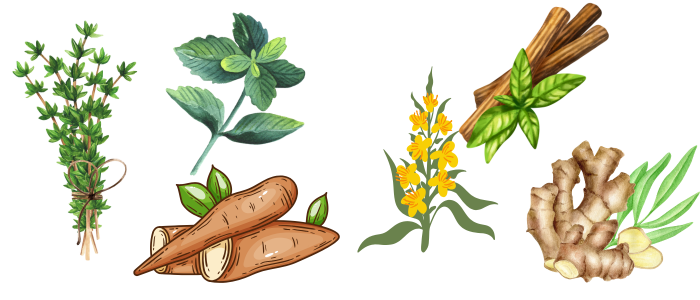How To Use A Lung-Clearing Herbal Nebulizer Solution: Natural Respiratory Support
Feb 20th 2025
Lung-Clearing Herbal Nebulizer Solution: Natural Respiratory Support
Breathe Easier with a Natural Lung-Clearing Nebulizer Solution

If you're struggling with congestion, chronic cough, or respiratory irritation, you don’t have to rely on pharmaceutical solutions alone. Herbal medicine offers a gentle yet effective way to support your lungs naturally. A lung-clearing nebulizer solution made from time-tested herbs can help clear mucus, reduce inflammation, and promote easier breathing, providing soothing relief right from the comfort of your home.
Whether you're recovering from a respiratory infection, managing asthma, or simply seeking lung support, herbal nebulizer therapy can offer a natural and powerful solution. In this blog, we’ll guide you on how to use a nebulizer, the best herbs for lung health, and how to make a safe and effective herbal nebulizer solution.
How to Use a Nebulizer for Lung Health
Using a nebulizer is simple, and it can be a great alternative for individuals who have difficulty using inhalers. Here's a quick guide:
-
Prepare Your Herbal Solution: You’ll need to make sure your solution is water-soluble—use hydrosols, saline-infused herbal preparations, or water-based extracts. Avoid essential oils, as they can irritate the lungs.
-
Fill the Nebulizer Chamber: Once you’ve prepared the solution, fill the nebulizer chamber with about 2-3 ml of the herbal saline solution.
-
Inhale: Turn on the nebulizer and inhale the mist deeply for 5-10 minutes. You can use the nebulizer 2-3 times per day as needed.
-
Clean Your Nebulizer: After each use, clean the nebulizer thoroughly to prevent any buildup of plant particles or bacteria.
Top 10 Herbs for Nebulizing (Lung Health)
Herbal nebulization can provide significant support for lung health when used properly. Here are 10 herbs commonly used for nebulization, their benefits, and the best form for nebulizing.

| Herb | Benefits for Lung Health | Best Form for Nebulization |
|---|---|---|
| Mullein (Verbascum thapsus) | Soothes lung inflammation, clears mucus, supports breathing. | Mullein leaf hydrosol or tea-infused saline |
| Eucalyptus (Eucalyptus globulus) | Acts as a natural decongestant, helps break down mucus. | Eucalyptus hydrosol (NOT essential oil!) |
| Thyme (Thymus vulgaris) | Antimicrobial, reduces respiratory infections, clears mucus. | Thyme tea-infused saline or hydrosol |
| Peppermint (Mentha piperita) | Relieves congestion, relaxes muscles in the respiratory tract. | Peppermint hydrosol or very diluted tea-infused saline |
| Ginger (Zingiber officinale) | Reduces lung inflammation, fights infections, improves circulation. | Ginger tea-infused saline (light dilution) |
| Astragalus (Huang Qi) (Astragalus membranaceus) | Boosts immune function, strengthens lungs, reduces inflammation. | Astragalus root decoction-infused saline |
| Licorice Root (Gan Cao) (Glycyrrhiza glabra) | Reduces lung inflammation, soothes irritation, helps with asthma. | Licorice root tea-infused saline |
| Osha Root (Ligusticum porteri) | Opens airways, fights respiratory infections, relieves cough. | Osha root decoction-infused saline |
| Schisandra (Wu Wei Zi) (Schisandra chinensis) | Tonifies lung Qi, reduces coughing, and strengthens lung function. | Schisandra berry infusion-infused saline |
| Dong Quai (Angelica Sinensis) | Improves circulation, regulates blood flow to the lungs, relieves cough. | Dong Quai root tea-infused saline |
How to Prepare Your Herbal Nebulizer Solution
Step-by-Step Instructions
Make the Herbal Infusion (Tea):
Boil 1 cup of distilled water.
Add your selected herbs (as noted above) and let them steep for 20-30 minutes.
Strain very well using a fine mesh strainer or coffee filter to remove all plant particles.
Dilute with Saline:
Mix 2 tablespoons of the herbal infusion with 2 tablespoons of sterile saline (0.9% sodium chloride solution) to ensure the solution is isotonic and safe for nebulization.
Use in the Nebulizer:
Pour 2-3 ml of the herbal saline solution into the nebulizer chamber.
Inhale deeply for 5-10 minutes.
Repeat 2-3 times per day as needed for respiratory relief.
Storage:
Store leftover herbal infusion in a sterile glass jar in the refrigerator for up to 24 hours.
Always prepare a fresh batch daily to prevent bacterial contamination.
Safety Tips for Nebulizer Use
Never Use Essential Oils: Essential oils can irritate the lungs and should never be used in a nebulizer.
Strain Well: Ensure that no plant particles remain in the herbal solution to avoid clogging the nebulizer.
Start Slowly: Begin with a low concentration of herbs, especially potent ones like Lobelia, and gradually increase the dosage as needed.
Consult a Doctor: If you have asthma, chronic lung disease, or other respiratory conditions, consult with your healthcare provider before using herbal nebulization.
Lung-Clearing Herbal Nebulizer Solution Recipe
This is an example of an herbal nebulizer solution helps clear mucus, reduce inflammation, and fight respiratory infections. It’s particularly effective for conditions like bronchitis, asthma, COPD, and post-viral lung recovery. Always follow your doctors instructions.
Ingredients:
1 cup (250ml) distilled water
1 tsp dried Mullein leaf
½ tsp dried Thyme
½ tsp dried Licorice root
¼ tsp dried Ginger root
¼ tsp dried Elecampane root
2 tbsp sterile saline (0.9% sodium chloride solution)
Instructions:
Make the herbal infusion: Boil 1 cup of distilled water. Add the herbs and steep for 20-30 minutes.
Strain well: Use a fine mesh strainer or coffee filter to remove plant particles.
Dilute with saline: Mix the strained herbal infusion with sterile saline.
Use in the nebulizer: Add 2-3 ml of the solution to the nebulizer chamber and inhale for 5-10 minutes.
Conclusion
Herbal nebulizer therapy offers an effective and natural way to support lung health. By using the right herbal preparations and following the proper procedures, you can relieve respiratory symptoms, clear mucus, and support healthy breathing. Always consult a healthcare provider, especially if you have pre-existing lung conditions, to ensure this therapy is right for you.
References
https://hort.extension.wisc.edu/articles/common-mullein-verbascum-thapsus/
https://pubmed.ncbi.nlm.nih.gov/16222647/
https://pmc.ncbi.nlm.nih.gov/articles/PMC5524553/
https://www.sciencedirect.com/topics/medicine-and-dentistry/elecampane
https://pmc.ncbi.nlm.nih.gov/articles/PMC9147557/
https://www.healthline.com/health/health-benefits-of-thyme
https://www.researchgate.net/publication/358754710_From_Monographs_to_Chromatograms_The_Antimicrobial_Potential_of_Inula_Helenium_L_Elecampane_Naturalised_in_Ireland
https://pmc.ncbi.nlm.nih.gov/articles/PMC8874828/
https://japer.in/storage/models/article/f5TqIxFdtRizpWUR7QJcIhbRLMXjYU2hTii7woeWds9ikCBkEPOjkXbppPnI/althaea-officinalis-in-traditional-medicine-and-modern-phytotherapy.pdf
https://www.nuhs.edu/botanical-medicine-marshmallow/
https://www.sciencedirect.com/science/article/pii/S0367326X1831596X
https://www.mskcc.org/cancer-care/integrative-medicine/herbs/lobelia
https://herbal-ahp.org/online-ordering-osha-root/
https://www.sciencedirect.com/science/article/abs/pii/S221478611830038X


